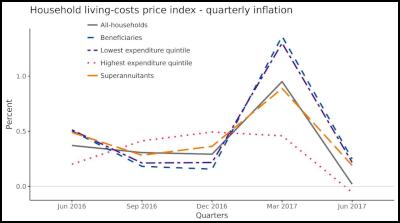Rising prices for essentials hit beneficiaries the hardest
Rising prices for essentials hit beneficiaries the
hardest
27 July 2017
Higher prices for housing and household utilities and food are hitting beneficiaries the hardest, while overall prices are dipping slightly for top earners, Stats NZ said today.
Beneficiaries experienced the highest inflation of all groups for the second quarter in a row, with their overall costs rising 0.3 percent in the June 2017 quarter. In contrast, the highest-earning group saw their cost of living fall 0.1 percent.
“Rising prices for the basics such as rent, electricity, and food had a greater impact on beneficiaries,” prices senior manager Jason Attewell said. “Over half their spending was on these essentials, compared with about a quarter for the highest earners.”
This data comes from the household living-costs price index (HLPIs), which are different from the overall basket of inflation measured by the CPI (see Consumers price index: June 2017 quarter). The HLPIs offer insights into how price changes affect 13 different household groups, including beneficiaries, Māori, superannuitants, and 10 other groups that have varying income and spending patterns. This differs from the CPI, which is a national average of price change that New Zealand households experience.
For more information on how the CPI works, see consumers price index – animation and infographic.
In the June 2017 quarter, higher prices for vegetables and electricity had a large effect on all groups. This was countered by lower prices for petrol.
“Items such as tomatoes and petrol are commonly purchased by households of all income and expenditure levels, and the impact of large price rises for these goods can be seen across the board,” Mr Attewell said. “In contrast, domestic airfares fell 15 percent across HLPI groups. High spenders benefitted the most from cheaper domestic airfares.”
High-tech items keep living costs low
Living costs for high-spending households rose the least in the year to June 2017, up 1.4 percent compared with 2 percent for low-spending households. High spending households spent proportionally more on high-tech items, which had price falls for the year.

Technology generally improves for items such as smartphones. This reflected as an effective price fall, as consumers receive more value for the same price. Mid to high earners and spenders have more discretionary income for high-tech items and receive the most benefit from these improvements.
For more information about these statistics:
• Visit Household Living-costs Price Indexes: June 2017 quarter
• See CSV files for download
ends


 Gordon Campbell: On bird flu, AUKUS entry fees and Cindy Lee
Gordon Campbell: On bird flu, AUKUS entry fees and Cindy Lee NZ Government: New Lab To Help Protect Key Pacific Tuna Fisheries
NZ Government: New Lab To Help Protect Key Pacific Tuna Fisheries Susan Botting - Local Democracy Reporter: Ruawai Leader Slams Kaipara Council In Battle Over $400k Property
Susan Botting - Local Democracy Reporter: Ruawai Leader Slams Kaipara Council In Battle Over $400k Property Te Pati Maori: Another ‘Stolen Generation’ Enabled By Court Ruling On Waitangi Tribunal Summons
Te Pati Maori: Another ‘Stolen Generation’ Enabled By Court Ruling On Waitangi Tribunal Summons Peace Action Wellington: Die In for Palestine Marks ANZAC day
Peace Action Wellington: Die In for Palestine Marks ANZAC day Labour Party: Penny Drops – But What About Seymour And Peters?
Labour Party: Penny Drops – But What About Seymour And Peters? Government: PM Announces Changes To Portfolios
Government: PM Announces Changes To Portfolios


